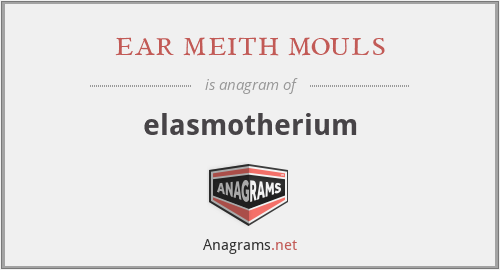What anagrams are available for elasmotherium?
This page is about an anagram for the word ear meith mouls that can be used in word games, puzzles, trivia and other crossword based board games.
ear meith mouls
Translation
Find a translation for ear meith mouls in other languages:
Select another language:
- - Select -
- 简体中文 (Chinese - Simplified)
- 繁體中文 (Chinese - Traditional)
- Español (Spanish)
- Esperanto (Esperanto)
- 日本語 (Japanese)
- Português (Portuguese)
- Deutsch (German)
- العربية (Arabic)
- Français (French)
- Русский (Russian)
- ಕನ್ನಡ (Kannada)
- 한국어 (Korean)
- עברית (Hebrew)
- Gaeilge (Irish)
- Українська (Ukrainian)
- اردو (Urdu)
- Magyar (Hungarian)
- मानक हिन्दी (Hindi)
- Indonesia (Indonesian)
- Italiano (Italian)
- தமிழ் (Tamil)
- Türkçe (Turkish)
- తెలుగు (Telugu)
- ภาษาไทย (Thai)
- Tiếng Việt (Vietnamese)
- Čeština (Czech)
- Polski (Polish)
- Bahasa Indonesia (Indonesian)
- Românește (Romanian)
- Nederlands (Dutch)
- Ελληνικά (Greek)
- Latinum (Latin)
- Svenska (Swedish)
- Dansk (Danish)
- Suomi (Finnish)
- فارسی (Persian)
- ייִדיש (Yiddish)
- հայերեն (Armenian)
- Norsk (Norwegian)
- English (English)
Definition
What does elasmotherium mean?
- Elasmotherium
- Elasmotherium is an extinct genus of large rhinoceros endemic to Eurasia during the Late Pliocene through the Pleistocene, existing from 2.6 Ma to at least as late as 39,000 years ago in the Late Pleistocene. A more recent date of 26,000 BP is considered less reliable. It was the last surviving member of Elasmotheriinae, a distinctive group of rhinoceroses that had separated from the ancestry of living rhinoceroses by at least 35 million years ago according to fossils and estimated around 47.4 million years ago based on molecular clock.Four species are recognised, which were largely confined to the Pontic–Caspian steppe, the Caucasus and Central Asia. The best known, E. sibiricum, known as the Siberian unicorn, was the size of a mammoth and is thought to have borne a large, thick horn on its forehead. Like all rhinoceroses, elasmotheres were herbivorous. Unlike any other rhinos and any other ungulates aside from some notoungulates, its high-crowned molars were ever-growing, and it was likely adapted for a grazing diet. Its legs were longer than those of other rhinos and were adapted for galloping, giving it a horse-like gait.
Embed
Citation
Use the citation below to add this anagram to your bibliography:
Style:MLAChicagoAPA
"ear meith mouls." Anagrams.net. STANDS4 LLC, 2024. Web. 15 May 2024. <https://www.anagrams.net/term/4244289>.



Discuss this elasmotherium anagram with the community:
Report Comment
We're doing our best to make sure our content is useful, accurate and safe.
If by any chance you spot an inappropriate comment while navigating through our website please use this form to let us know, and we'll take care of it shortly.
Attachment
You need to be logged in to favorite.
Log In